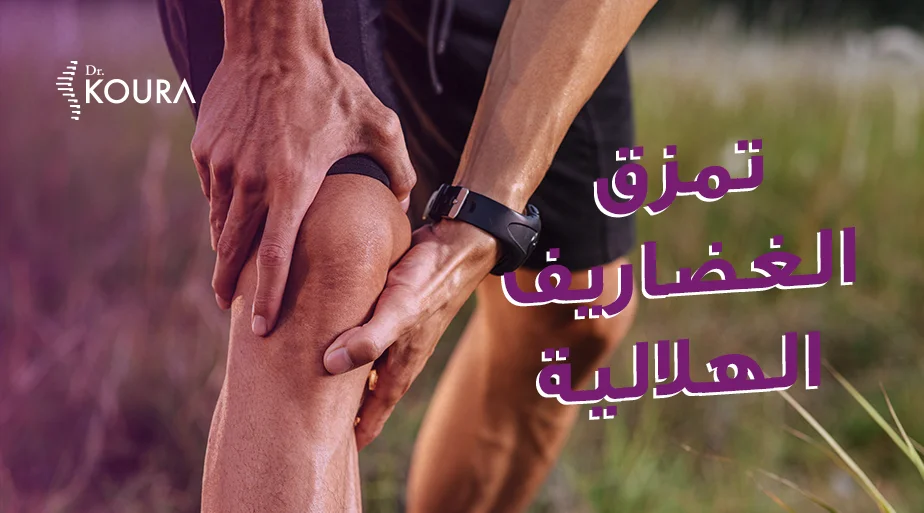Torn meniscus
Meniscus Tears and its Non-Surgical Treatment
The meniscus is a fundamental component in providing cushioning and protection for joints, but its susceptibility to tearing can lead to serious health issues. In this context, the focus is on finding effective non-surgical treatment methods to alleviate the pain of meniscal cartilage tears and promote natural joint healing.
Dr. Mohamed Koura Center stands as a pioneer in the non-surgical treatment of meniscus tears, combining cutting-edge medical technologies with a specialized medical team.
In this article, we will closely examine the concept of meniscus tears, understand their impact on joints, and explore the modern treatment approaches offered by Dr. Mohamed Koura Center to achieve joint healing and enhance the quality of life for patients.
What is the Meniscus?
The meniscus consists of connective tissues containing a high concentration of collagen fibers, with cartilage cells interspersed between them.
In the knee joint, there are two cartilaginous pads that separate the femur and tibia bones, namely the inner meniscus and the outer meniscus.
What is the function of Meniscus?
The function of meniscus includes:
- Contributing to the stability of the knee joint.
- Acting as cushions to reduce friction between the femur and tibia bones, absorbing shocks from walking and running.
- Distributing synovial fluid across the surface of the joint cartilages for nourishment.
- Assisting in distributing weight evenly across the entire surface of the tibial plateau, preserving the joint cartilages covering the bone surfaces.
What are the types of Meniscus?
There are two types of meniscus in the knee joint, as follows:
- Lateral Meniscus
Crescent-shaped, connected to the lateral collateral ligament.
Bears greater pressure and load during knee rotation outward.
- Medial Meniscus:
Tends to be more circular in shape, not connected to the medial collateral ligament.
Has a larger range of motion compared to the lateral meniscus.
More mobile during knee bending, making it less prone to injuries compared to the lateral meniscus.
These meniscuses are connected by a transverse ligament in the front. They distribute pressure on the joint surfaces, absorbing approximately 30-70% of stress and pressure on the joint surface.
The distribution of pressure on the meniscal cartilages depends on the degree of knee flexion, absorbing 50% of stress in full knee extension and 80% in knee flexion.
Scientific experiments and studies have shown that complete removal of the lateral meniscus leads to a reduction in the contact area with the joint surface by 50-70%, significantly increasing stress on the joint surface cartilage.
What are the causes of Meniscus Tear?
The causes of meniscus tear vary depending on the age group, as follows:
- Early Stages of Aging:
Tear may be associated with discoid meniscus during early age stages.
- Young Adults and Athletes:
Tear in one of the meniscus may occur due to knee joint injuries, such as falls or twisting of the knee.
Meniscus tear can also accompany other knee injuries, such as anterior cruciate ligament (ACL) tears.
- Advanced Aging Stages:
Meniscus tear may occur without severe knee injuries, attributed to the weakening and wear of cartilage with aging, especially in cases of knee osteoarthritis.
Meniscus tears can happen due to various reasons:
External Injuries
Often occur in cases of knee joint twisting, which can happen during falls or sports injuries.
If sports-related, meniscus injuries may be isolated or accompanied by other injuries such as ACL tears.
Degenerative Changes in Meniscus
Often occur with aging or chronic stress on the meniscal cartilage, especially in the presence of joint surface cartilage injuries.
The likelihood of meniscus tears increases with bow-legged or knock-kneed, as these conditions result in increased load on the inner or outer meniscus, respectively.
What are the symptoms of Meniscus Tear?
The symptoms of a tear in the medial meniscus differ from those in the lateral meniscus, as follows:
Symptoms of a Medial Meniscus Tear
- Pain on the inner side of the knee, and pain may occur during or after any activity.
- Sudden locking of the joint in various positions, indicating the inability to fully extend or flex the knee, leaving it in a fixed position.
- Pain on the inner side of the knee during full extension and flexion, as well as when rotating the knee outward at a bending angle between 70-90 degrees.
- Mild swelling of the knee due to joint fluid accumulation, usually occurring after strenuous activities.
Symptoms of a Lateral Meniscus Tear
- Pain on the outer side of the knee during and after activities, with pain often recurring after specific types of physical exertion.
- Sudden locking or catching of the joint.
- Pain during knee extension and flexion, as well as discomfort when internally rotating the knee at an angle between 70-90 degrees.
- Mild swelling of the joint and occasional joint effusion.
What are the non-surgical treatment methods of Meniscus Tear?
The treatment of meniscus tear depends on several factors, including the following:
- Patient's age, the type of activity they engage in.
- The type and location of the tear.
- The severity of symptoms.
Here are some non-surgical treatment methods:
- Placing ice on the patient's knee while elevating it can help reduce swelling.
- Applying a compression bandage to the knee helps minimize the chance of knee effusion.
- Providing the patient with medications that aid in reducing pain and swelling.
- Avoiding intense physical activities for a duration determined by the treating doctor.
For cases where meniscus tears are associated with knee osteoarthritis, non-surgical options may include:
- If the knee is locked, the torn part may be removed through endoscopy.
- Injecting the knee with platelet-rich plasma to aid in the healing of the meniscus torn.
In conclusion, meniscus torn appears as a common and painful issue that significantly impacts individuals' quality of life. Nevertheless, several non-surgical treatment methods emerge as effective options for alleviating pain and enhancing joint function. Among these approaches, knee injections stand out as a modern method that demonstrates efficacy in cartilage restoration and stimulates healing processes without the need for traditional surgery. Non-surgical treatment for meniscus torn is available at Dr. Mohamed koura's center, recognized as the best physician in this field. He stays consistently updated on the latest scientific advancements in treatment techniques through active participation in various international conferences alongside leading doctors and experts from around the world.
Book your appointment now from the comfort of your home using the provided contact numbers and benefit from the best medical services.





 Egypt
Egypt